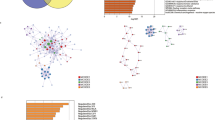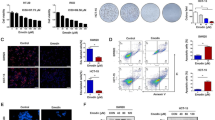Abstract
Background
Urinary bladder cancer (UBC) is considered one of the most prevalent malignant tumors worldwide. Complementary and integrative approaches for the treatment of bladder cancer, such as the intake of isoflavonoid phytoestrogens, are of increasing interest due to the risk of mortality and long-term morbidity associated with surgical procedures. The biological effects of prunetin, one of the less-studied phytoestrogens, have not yet been examined in this respect. Therefore, this study aimed to explore the efficacy of prunetin on UBC cells (RT-4).
Methods and results
The cytotoxicity and nitric oxide synthase activities of prunetin were determined in cell cultures. The expression of apoptosis-related genes was determined with RT-PCR. Cell cycle assays were performed using a flow cytometer and cellular apoptotic rate was measured. The results suggested that prunetin has cytotoxic effects at 21.11 µg/mL on RT-4 cells. Flow cytometry analysis showed that prunetin induced apoptosis and arrested th cell cycle in the G0/G1 phase. Prunetin exposure was associated with increases in CASP3 and TNF-α gene expression in RT-4 cells at doses of 21.11 and 42.22 µg/mL, respectively. Strong nitric oxide inhibition was observed at IC50 of 5.18 µg/mL under macrophage mediated inflammatory circumstances.
Conclusions
Prunetin possesses anti-cancer properties and may be a candidate compound for the prevention of UBC. This is the first study that evaluated prunetin for its in vitro antitumor activities, clarified its possible apoptotic molecular mechanism and provided novel insights into its anti-inflammatory nature and effects on the expression of related key genes.





Similar content being viewed by others
References
Stewart W, Wild C (eds) (2014) World cancer report. International Agency for Research on Cancer, Lyon
Global Cancer Observatory (2021) WHO bladder cancer factsheet. Accessed on 13 Feb 2021
Apaya KM, Chang TM, Shyur FL (2016) Phytomedicine polypharmacology: cancer therapy through modulatingthe tumor microenvironment and oxylipin dynamics. Pharmacol Therapeut 162:58–68
Gunasekaran T, Haile T, Nigusse T, Dhanaraju DM (2014) Nanotechnology: an effective tool for enhancing bioavailability and bioactivity of phytomedicine. Asian Pac J Trop Biomed 4:1–7. https://doi.org/10.12980/APJTB.4.2014C980
Farzaei HM, Shahpiri Z, Bahramsoltani R, Moghaddam M, Najafi F, Rahimi R (2017) Efficacy and tolerability of phytomedicines in multiple sclerosis patients: a review. CNS Drugs 31:867–889
Norrby M. Madej A. Ekstedt E, Holm L (2013) Effects of genistein on oestrogen and progesterone receptor, proliferative marker Ki-67 and carbonic anhydrase localisation in the uterus and cervix of gilts after insemination. Anim Reprod Sci 138:90–101
Kašparová M (2013) Phytoestrogens from red clover. Prakt lékáren 9:201–203. https://doi.org/https://www.praktickelekarenstvi.cz/pdfs/lek/2013/04/11.pdf
Rajput SM, Sarkar DP (2017) Modulation of neuro-inflammatory condition, acetylcholinesterase and antioxidant levels by genistein attenuates diabetes associated cognitive decline in mice. Chem Biol Interact 268:93–102
Sarasquete C, Manzanaro UM, Ortiz-Delgado BJ (2018) Toxicity and non-harmful effects of the soya isoflavones, genistein and daidzein, in embryos of the zebrafish, Danio rerio. Comp Biochem Physiol C Toxicol Pharmacol 211:57–67
Basu P, Maier C (2018) Phytoestrogens and breast cancer: in vitro anticancer activities of isoflavones, lignans, coumestans, stilbenes and their analogs and derivatives. Biomed Pharmacother 107:1648–1666
Liu X, Sun C, Jin X, Li P, Ye F, Zhao T, Gong L, Li Q (2013) Genistein enhances the radio-sensitivity of breast cancer via G (2)/M cell cycle arrest and apoptosis. Molecules 18:13200–13217
Sandhua VK, Demiray YE, Yanagawa Y, Stork O (2020) Dietary phytoestrogens modulate aggression and activity in social behavior circuits of male mice. Horm Behav 119:104637. https://doi.org/10.1016/j.yhbeh.2019.104637
Pan W, Ikeda K, Takebe M, Yamori Y (2001) Genistein, Daidzein and glycitein inhibit growth and DNA synthesis of aortic smooth muscle cells from stroke-prone spontaneously hypertensive rats. J Nutr 131:1154–1158
Chen C, Wang Y, Chen S, Ruan X, Liao H, Zhang Y, Sun J, Gao J, Deng G (2020) Genistein inhibits migration and invasion of cervical cancer HeLa cellsby regulating FAK-paxillin and MAPK signaling pathways. Taiwan J Obstet Gyne 59:403–408
Hu H, Li H (2018) Prunetin inhibits lipopolysaccharide-induced inflammatory cytokine production and MUC5AC expression by inactivating the TLR4/MyD88 pathway in human nasal epithelial cells. Biomed Pharmacother 106:1469–1477
Yang G, Ham I, Choi YH (2013) Anti-inflammatory effect of prunetin via the suppression of NF-kB pathway. Food Chem Toxicol 58:124–132
Mosmann T (1983) Rapid colorimetric assay for cellular growth and survival: application to proliferation and cytotoxicity assays. J Immunol Methods 65:55–63
Zhang J, Liu L, Wang J, Ren B, Zhang L, Li W (2018) Formononetin, an isoflavone from Astragalus membranaceus inhibits proliferation and metastasis of ovarian cancer cells. J Ethnopharmacol 221:91–99
Nalbantsoy A, Nesil T, Yılmaz-Dilsiz Ö, Aksu G, Khan S, Bedir E (2012) Evaluation of the immunomodulatory properties in mice and in vitro anti-inflammatory activity of cycloartane type saponins from Astragalus species. J Ethnopharmacol 139:574–581
Feng-Ying Z, Shun-Xing L, Lu-Xiu L (2007) Assessment of bioavailability and risk of iron in phytomedicines Aconitum carmichaeli and Paeonia lactiflora. J Trace Elem Med Biol 21:77–83
Militao GC, Pinheiro SM, Dantas IN, Pessoa C, de Moraes MO, Costa-Lotufo LC, Lima MA, Silveira ER (2007) Bioassay-guided fractionation of ptero-carpans from roots of Harpalyce brasiliana Benth. Bioorg Med Chem 15:6687–6691
Szliszka E, Czuba PZ, Mertas A, Paradysz A, Krol W (2013) The dietary isoflavone biochanin—a sensitizes prostate cancer cells to TRAIL-induced apoptosis. Urol Oncol 31:331–342
Kuete V, Sandjo PL, Kwamou NMG, Wiench B, Nkengfack EA, Efferth T (2014) Activity of three cytotoxic isoflavonoids from Erythrina excelsa and Erythrina senegalensis (neobavaisoflavone, sigmoidin H andisoneorautenol) toward multi-factorial drug resistant cancer cells. Phytomedicine 21:682–688
Yan Y, Chai ZC, Wang WD, Wu J, Xiao HH, Hou XL, Zhu ND, Yu Y (2014) Simultaneous determination of puerarin, daidzin, daidzein, paeoniflorin, albiflorin, liquiritin and liquiritigenin in rat plasma and its application to a pharmacokinetic study of Ge-Gen Decoction by aliquid chromatography–electrospray ionization-tandem massspectrometry. J Pharm Biomed Anal 95:76–84
Sarfraz A, Javeed M, Shah AM, Hussain G, Shafiq N, Sarfraz I, Riaz A, Sadiqa A, Zara R, Zafar S, Kanwal L, Sarker DS, Rasul A (2020) Biochanin A: a novel bioactive multifunctional compound from nature. Sci Total Environ 722:137907
Ma HC, Zhang XY, Tang HL, Yang JX, Cui MW, Han CC, Ji YW (2018) MicroRNA-1469, a p53-responsive microRNA promotes Genistein induced T apoptosis by targeting Mcl1 in human laryngeal cancer cells. Biomed Pharmacother 106:665–671
Alkhamaiseh IS, Aljofan M (2020) Prevalence of use and reported side effects of herbal medicine among adultsin Saudi Arabia. Complement Ther Med 48:102255
Po LS, Wang TT, Chen ZY, Leung LK (2002) Genistein-induced apoptosis in MCF-7 cells involves changes in Bak andBcl-x without evidence of anti-oestrogenic effects. Br J Nutr Title 88:463–469. https://doi.org/10.1079/BJN2002693
Wang X, Clubbs EA, Bomser JA (2006) Genistein modulates prostateepithelial cell proliferation via estrogen- and extracellular signal-regulatedkinase-dependent pathways. J Nutr Biochem 17:204–2410
Choi JE, Kim T, Lee SM (2007) Pro-apoptotic effect and cytotoxicity of genistein and genistin in humanovarian cancer SK-OV-3 cells. Life Sci 80:1403–1408
Hsu NY, Shyu WH, Hu WT, Yeh PJ, Lin WY, Lee YL, Yeh TY, Dai YH, Perng SD, Su HS, Huang HY, Su JS (2018) Anti-proliferative activity of biochanin A in human osteosarcoma cells viamitochondrial-involved apoptosis. Food Chem Toxicol 112:194–204
Sallama AAA, Allam MR (2021) Promising targets of chrysin and daidzein in colorectal cancer: Amphiregulin, CXCL1, and MMP-9. Eur J Pharmacol 892:173763. https://doi.org/10.1016/j.ejphar.2020.173763
Maphanao P, Thanan R, Loilome W, Chio-Srichan S, Wongwattanakul M, Sakonsinsiri C (2020) Synchrotron FTIR microspectroscopy revealed apoptosis-induced biomolecular changes of cholangiocarcinoma cells treated with ursolic acid. Biochim Biophys Acta 1864:129708. https://doi.org/10.1016/j.bbagen.2020.129708
Livak KJ, Schmittgen TD (2001) Analysis of relative gene expression data using real-time 43 quantitative PCR and the 2(-Delta Delta C(T)) Method. Methods 25(4):402–428
Bi YL, Min MS, Yan LW (2018) Genistein induced anticancer effects on pancreatic cancer cell lines involves mitochondrial apoptosis, G0/G1cell cycle arrest and regulation of STAT3 signalling pathway. Phytomedicine 39:10–16
Wang B, Xu H, Hu X, Ma W, Zhang J, Li Y, Yu M, Zhang Y, Li X, Ye X (2020) Synergetic inhibition of daidzein and regular exercise on breast cancer in bearing-4T1 mice by regulating NK cells and apoptosis pathway. Life Sci 245:117387
Idriss HT, Naismith JH (2000) TNF alpha and the TNF receptor superfamily: structure-function relationship(s). Microsc Res Tech 50:84–95
Hayashi T, Yamada K, Esaki T, Kuzuya M, Satake S, Ishikawa T, Hiaka H, Iguchi A (1995) Estrogen increases endothelial nitricoxide by a receptor mediated system. Biochem Biophys Res Commun 214:847–855
You HJ, Kim JY, Jeong GH (2003) 17b-Estradiol increases induciblenitric oxide synthase expression in macrophages. Biochem Biophys Res Commun 303:1129–1134
Sharma A, Joshi R, Kumar S, Sharma R, Rajneesh, Padwad Y, Gupta M (2018) Prunus cerasoides fruit extract ameliorates inflammatory stress by modulation of iNOS pathway and Th1/ Th2 immune homeostasis in activated murine macrophages and lymphocytes. Inflammopharmacology 26:1483–1495
Nakaya M, Tachibana H, Yamada K (2005) Isoflavone genistein and daidzein up-regulate LPS-inducedinducible nitric oxide synthase activity through estrogenreceptor pathway in RAW264.7 cells. Biochem Pharmacol 71:108–114
Acknowledgements
The authors would like to thank Prof. Dr. Anne FRARY from Department of Molecular Biology & Genetics, Izmir Institute of Technology, Izmir, Turkey, for providing kind advice during the drafting of this manuscript. This paper has been submitted to a preprint platform with https://doi.org/10.21203/rs.3.rs-445738/v1.
Funding
This work was supported by The Scientific and Technological Research Council of Turkey (TUBITAK, Grant No. 119Z028).
Author information
Authors and Affiliations
Contributions
ÇKK designed and performed the study and wrote the manuscript. AN prepared the cells for cell culture and performed the cytotoxcity test. NUKY performed the statistical analysis and interpreted data. All authors reviewed the manuscript.
Corresponding author
Ethics declarations
Conflict of interest
The authors declare they have no conflicts of interest or competing interests.
Ethical approval
Ethical approval was not required because the experiments utilized in vitro cell culture techniques.
Consent to participate
The study did not use human subjects.
Research involving human and/or animal participants
This work does not contain any studies with human or animal subjects.
Additional information
Publisher’s Note
Springer Nature remains neutral with regard to jurisdictional claims in published maps and institutional affiliations.
Rights and permissions
About this article
Cite this article
Köksal Karayildirim, Ç., Nalbantsoy, A. & Karabay Yavaşoğlu, N.Ü. Prunetin inhibits nitric oxide activity and induces apoptosis in urinary bladder cancer cells via CASP3 and TNF-α genes. Mol Biol Rep 48, 7251–7259 (2021). https://doi.org/10.1007/s11033-021-06719-w
Received:
Accepted:
Published:
Issue Date:
DOI: https://doi.org/10.1007/s11033-021-06719-w




